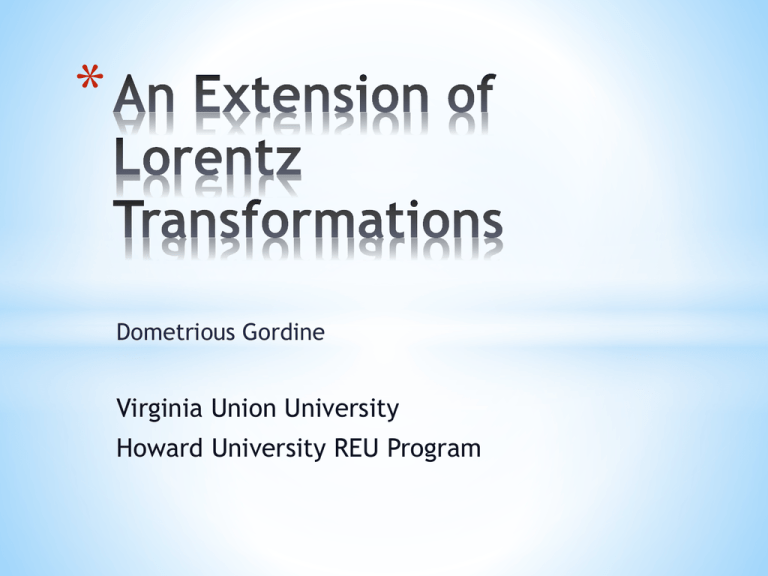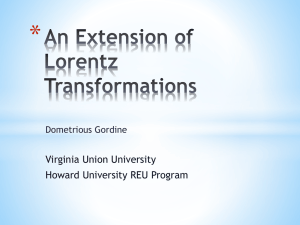Final 7/31/14 presentation
advertisement

* Dometrious Gordine Virginia Union University Howard University REU Program * * Maxwell’s Equations Gauss & Ampere * Lorentz transformations (symmetry of Maxwell’s equations) Gauss & Faraday Q: Can we extend to non-constant v? v is a constant (matrix format) * * Q: Can we extend Lorentz transformations, but so as to still be a symmetry of Maxwell’s equations? * Generalize v → v0 + aμxμ = v0 + a0x0 + a1x1 + a2x2 + a3x3 * Expand all functions of v, but treat the aμ as small… … … is messy * For example, expanding * …turns the standard Lorentz-boost matrix * …into: …so that * * Even just one specific electric and magnetic field component: This is clearly exceedingly unwieldy. We need a better approach. * * Use the formal tensor calculus * Maxwell’s equations: * General coordinate transformations: note: opposite derivatives Transform the Maxwell’s equations: Use that the equations in old coordinates hold. Compute the transformation-dependent difference. Derive conditions on the aμ parameters. * * The Gauss-Ampere equations: * …transform as Should vanish, = “condition X” The original equation, = 0 * * This produces “Condition X”: * where we need this “X” to vanish. * Similarly, transforming the second half: * produces “Condition Y”: * where we need this “Y” to vanish. * These conditions, “X=0” and “Y=0” insure that the particular coordinate transformation is a symmetry of Maxwell equations * They comprise 2·24 = 48 equations, for only 4 parameters aμ ! * * The Conditions are “reciprocal” * …in the former, new coordinates are functions of the old, * …in the second, old coordinates are functions of the new. * Introduce “small” deviations from linearity, * …so that the inverse transformation is, to lowest order: * Insert these into “X” and “Y” above; keep only 1st order terms. * * For example, * Multiply out, compute derivatives, while keeping 1st order terms: * Now contract with the inverse-transformation: * …which expands (to 1st order) to: * …and simplifies upon transforming ν (“nu”) to the new system * * Writing out the small A’s for every choice of every free index: Most of these vanish to 1st order. * * Writing out the conditions, for every choice of the free index… * For example, * Similarly, we obtain a0 = 0. * However, there appear no restrictions on a2 and a3. * Since the initial coordinate system was chosen so the Lorentzboost is in the x- (i.e., 1st) direction, the “X = 0” conditions allow Lorentz-boosts with * * The “Y = 0” conditions are evaluated in the same fashion * A little surprisingly, they turn out to produce no restriction on the remaining extension parameters, a2 and a3. * Summarizing: * This permits velocities that are: * homogeneous (same direction everywhere) * constant in time (no acceleration/deceleration) * but the magnitude of which may vary (linearly, slowly) in directions perpendicular to the boost velocity * * Open questions: * Second and higher order effects (some conditions on a2 and a3 ?) * Combination of Lorentz-boosts with rotations * Consequences on the relativistic mechanics of moving bodies * …and especially, moving charged bodies. * Acknowledgments: * Funding from the REU grant PHY-1358727
